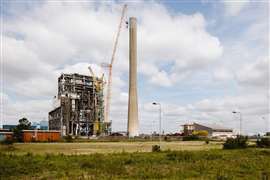Hungarian prospects
27 February 2008
According to the latestdata from the Hungarian Central Statistical Office (HCSO) the volume of construction activity in Hungary decreased in June 2007 by -15,8% when compared with June 2006. Building construction fell by -15,2% and civil engineering decreased by -16,6%.
The statistics show that this is a persistent trend, and not just a sudden dip for June. In the first six months of 2007 building construction fell by -1,3% while civil engineering was down by 6,8% as compared with the first six months of 2006.
But What is happening?
Hungary's real estate boom lasted until mid 2005, with a dynamic increase in the number of new houses and office buildings. According to the statistics, 0,5 million people took out a mortgage between 2000 and 2005. Many now think the good times are over for the residential construction sector, and the statistics seem to support this.
According to major developers, there is little new day-to-day demand in the residential sector. A key symptom of this was the level of orders in the sector, which was -23% lower at the end of June than it was for the same month in 2006.
The number of small houses under 40 m2 is growing, that of 40-60 2 has further increased, but the number of homes above 100 2 has been reduced significantly. The price of new apartments in the capital is now around HUF 0,27 to 0,80 million per 2 (€ 1080 to 3200 per 2) in 2007.
Market commentators think that the main factors impeding construction are the high prices of houses and of building materials together with the decrease in the Hungarian population and the high inflation rate due to the fulfilment of the Maastricht obligations. In addition to these factors, in December 2003, restrictions on new loans began to squeeze the housing market, causing a slowdown in 2004 and in the first half of 2005.
But while residential building has slowed since mid-2005, Hungary is still seeing strong demand in the non-residential construction sector, especially the office and retail sectors which are relatively saturated with well-established domestic developers like OTP Bank, Trigránit, MOL and Wallis Ingatlan.
On the other hand, foreign developers continue to invest heavily in logistics, industrial and commercial property developments. Compared to previous years, commercial investments such as shopping and entertainment centres and hypermarkets are developing strongly across the whole country, as a consequence of the inflow of foreign capital.
The civil engineering sector constituted 45% of the overall construction activity in 2006. After a strong rise in 2005, civil engineering investments have decreased by -7,5% in two years.
Transport-related investments are of crucial importance in this sector, and the Hungarian government has been putting a special emphasis on motorway construction and other public roads since 2002. However, many of the biggest and most important motorway schemes are set to finish this year. As a result, the volume of new orders for road construction, which at one time represented 25% of all construction activity, decreased in 2007.
The fall in residential construction and civil engineering has led to the overall fall in construction activity, and the Hungarian construction sector has been in recession since mid-2005. In addition to these circumstances, the rising price of oil and other materials has pushed up price inputs in the sector. Unless there is a sudden upswing, these factors seem set to make 2006 and 2007 two of the weakest year's in the Hungarian construction industry's recent history.
New Initiatives
On the positive side, however, the Hungarian Government is preparing special loan programmes in order to make the present housing policy easier. Similarly, in the non-residential construction sector, the speed-up of community investments started in 2005 may result in a sudden growth in the number of orders in the following years.
Finally, and perhaps most importantly, the investments in civil engineering will mainly depend on the volume of transport investments, motorway construction, especially. As EU membership leads to the modernising investments that are needed in public road transport. We expect these to increase +12% to +15% in 2008.
The importance of construction industry activity to the development of the Hungarian economy cannot be underestimated. The overall outlook is not particularly promising for the future, and a glance at the order backlog for construction shows it is not a temporary problem. However, there is still a pent up demand from people to improve the quality of their residences, and several Public Private Partnership (PPP) construction projects began in the second half of 2007, which will have a positive impact on non-residential construction activity in the coming years.
Finally, due to the development of motorway investments, which is supported both by the Second National Development Plan of Hungary (2007 to 2013) and the Cohesion Fund of the EU, we expect a considerable market growth from 2008 in civil engineering. Overall therefore, we predict an annual +10% to +12% growth in the construction industry for the next two-to-three years.
STAY CONNECTED


Receive the information you need when you need it through our world-leading magazines, newsletters and daily briefings.
CONNECT WITH THE TEAM










